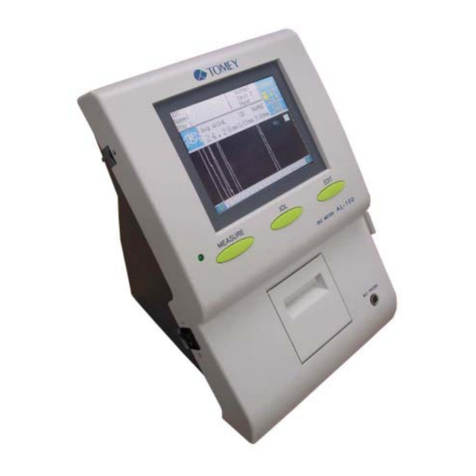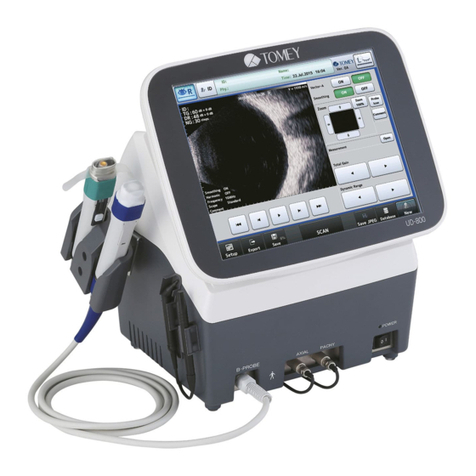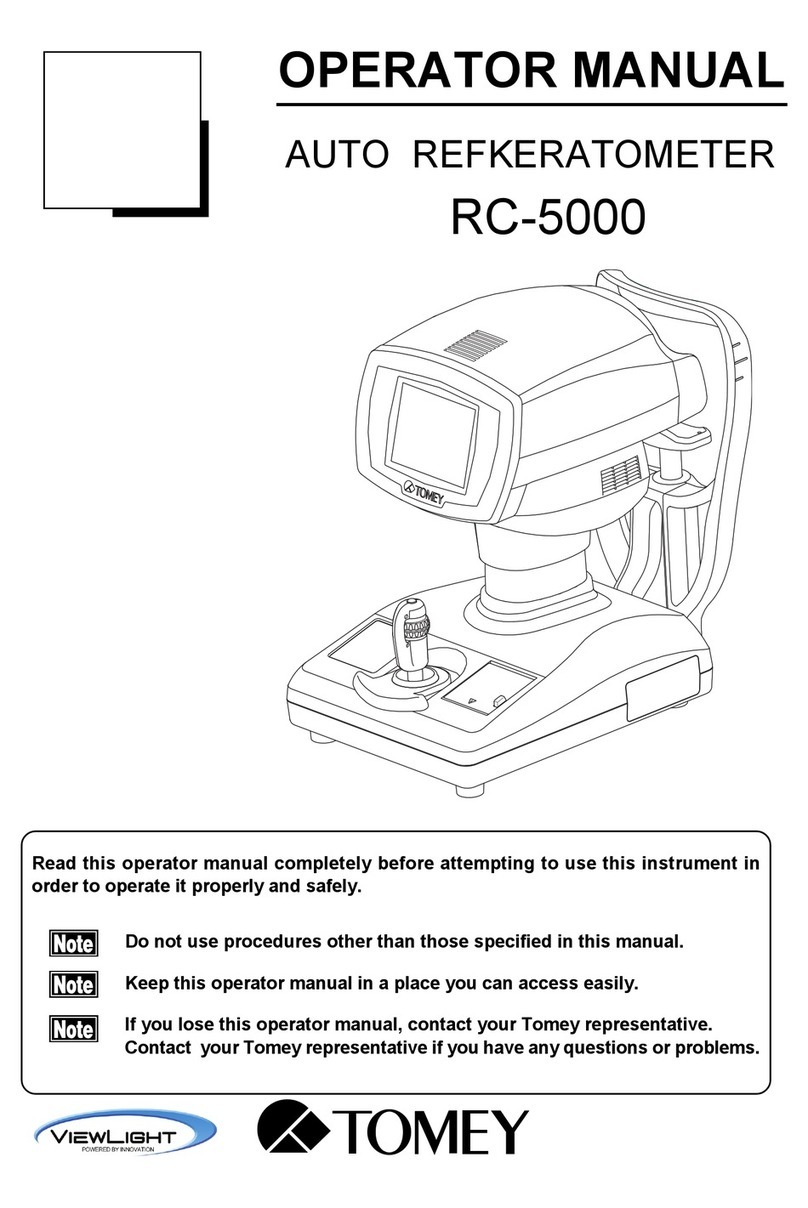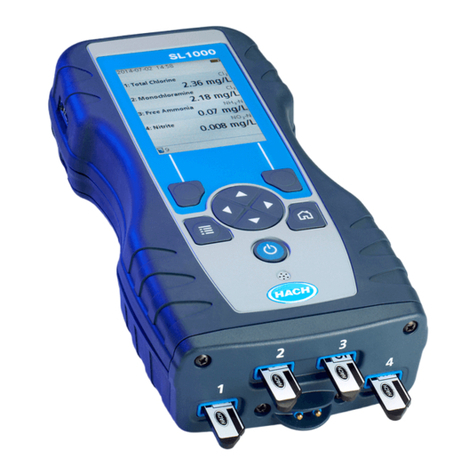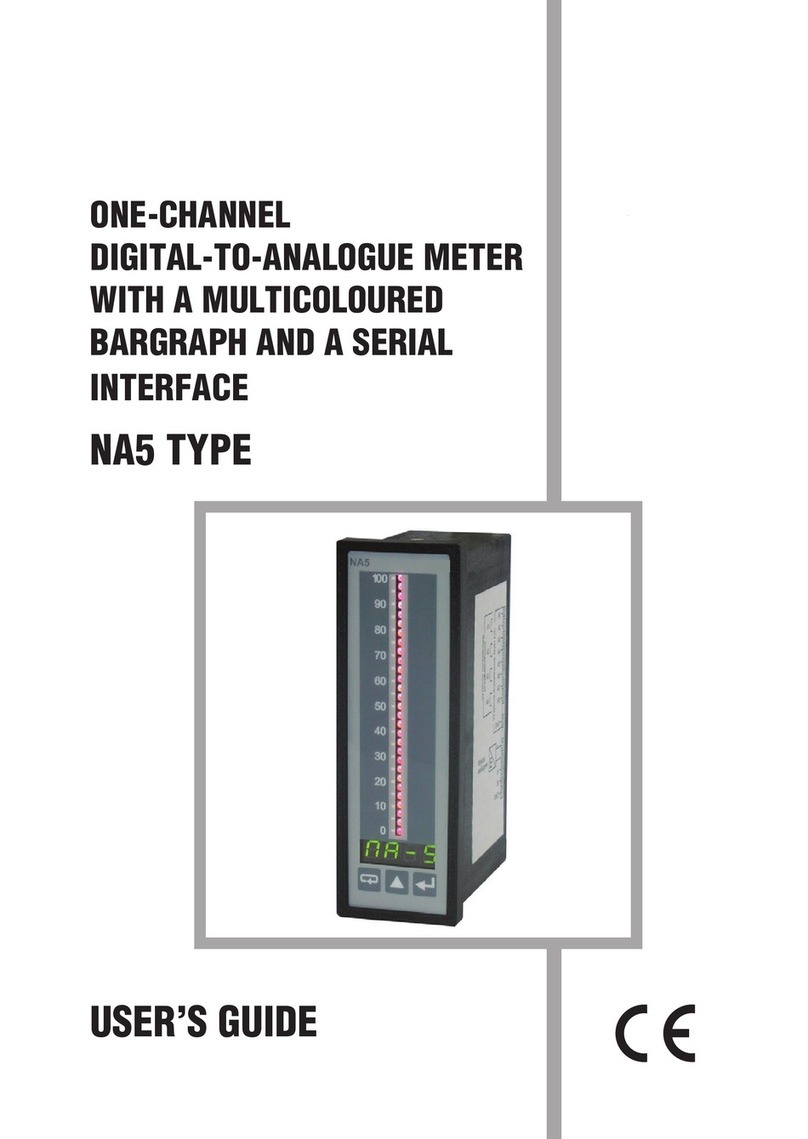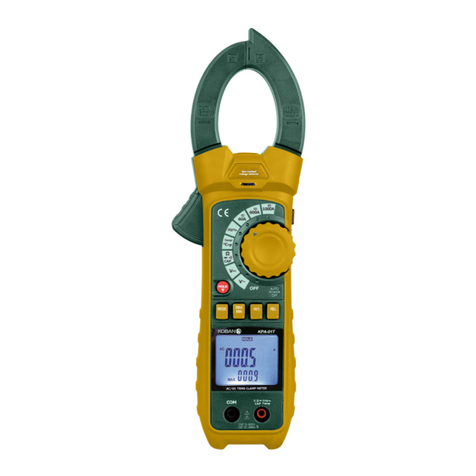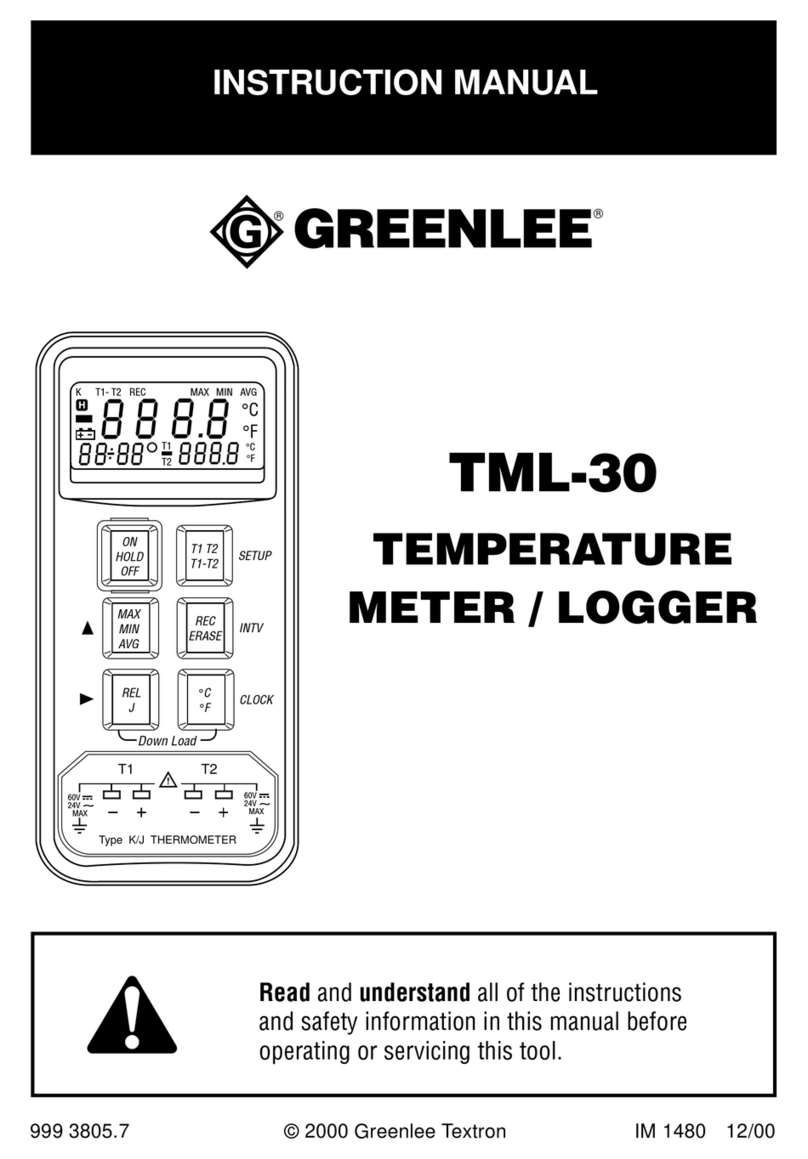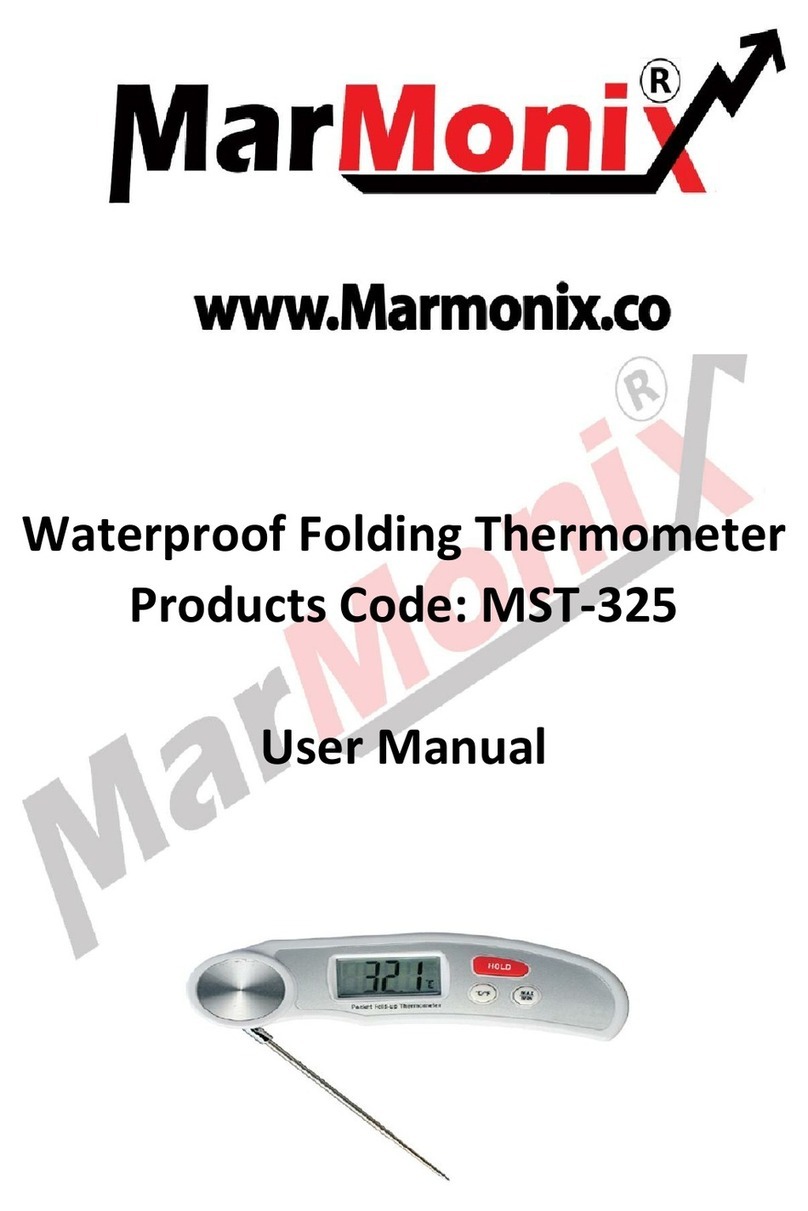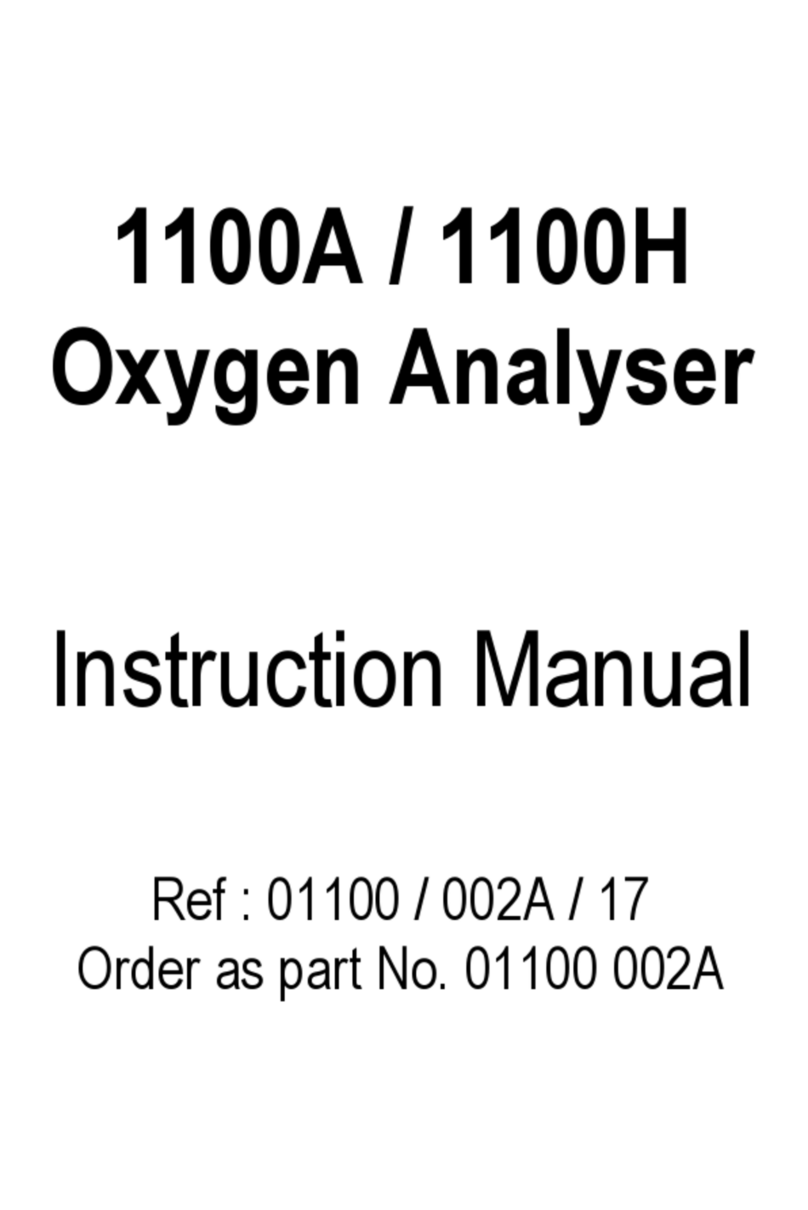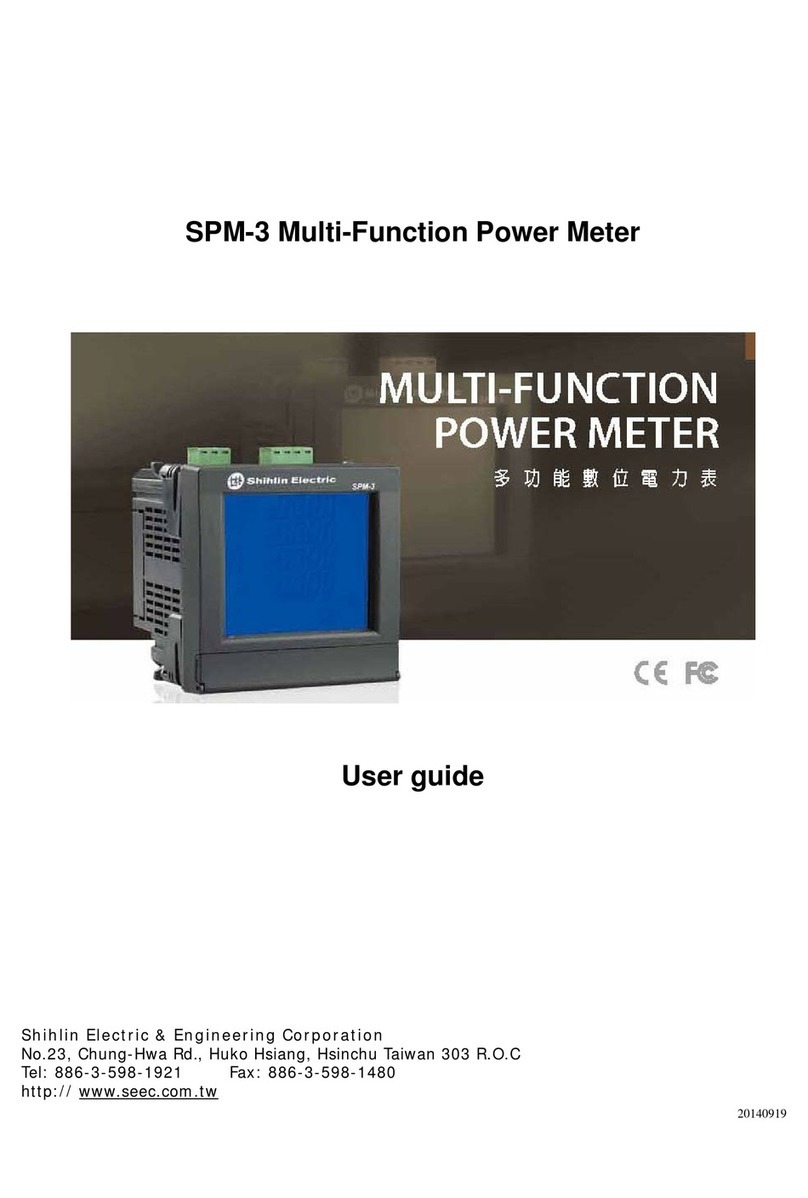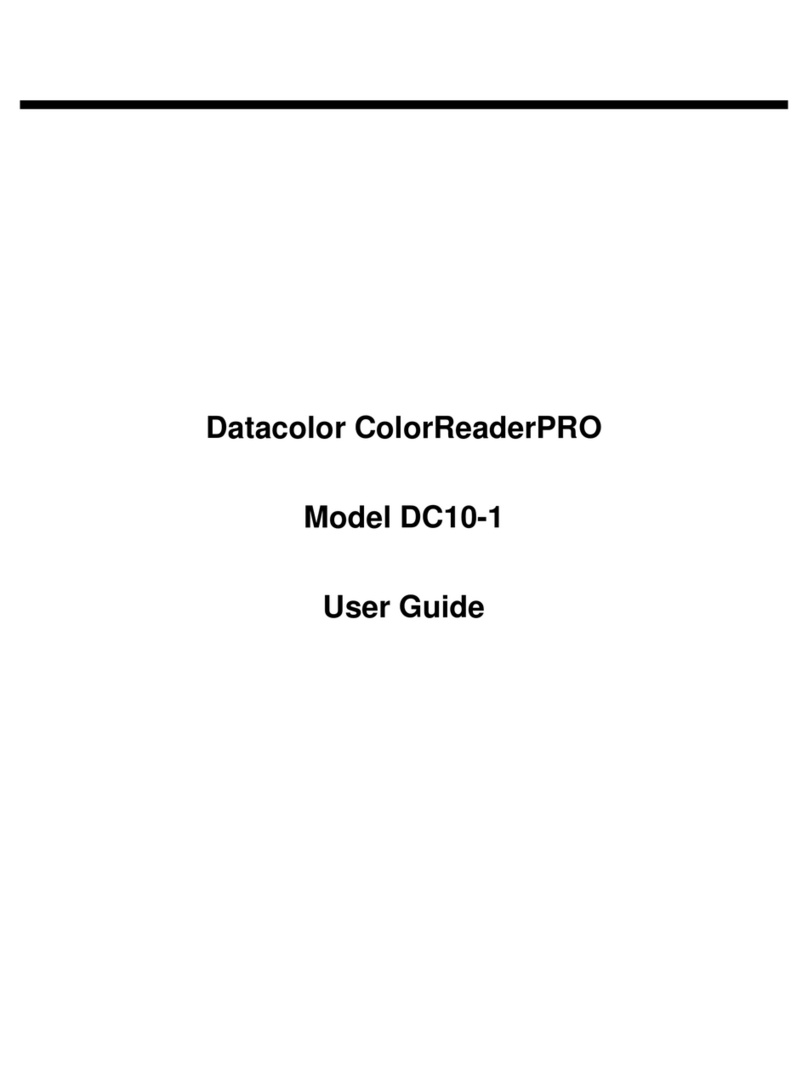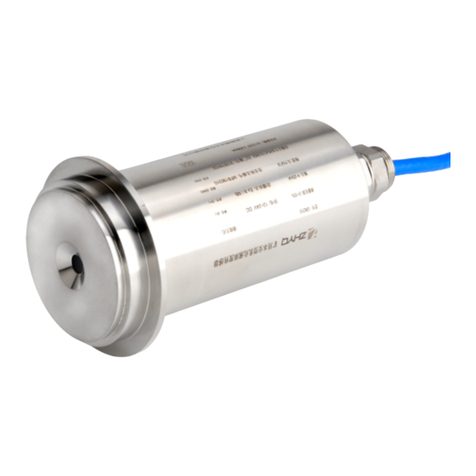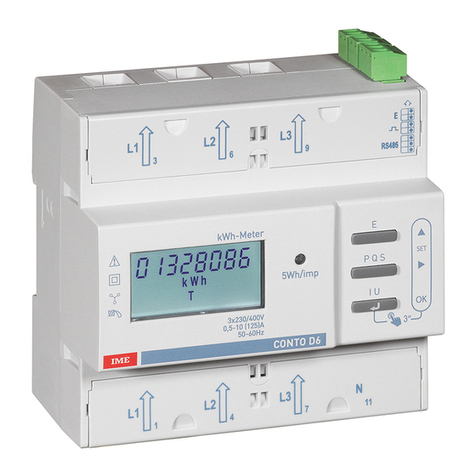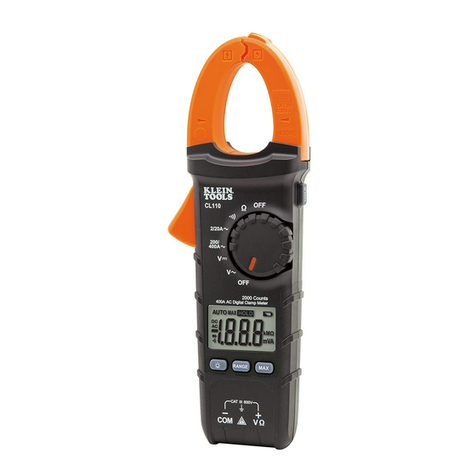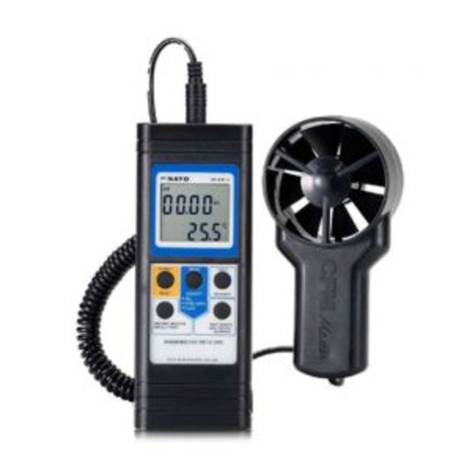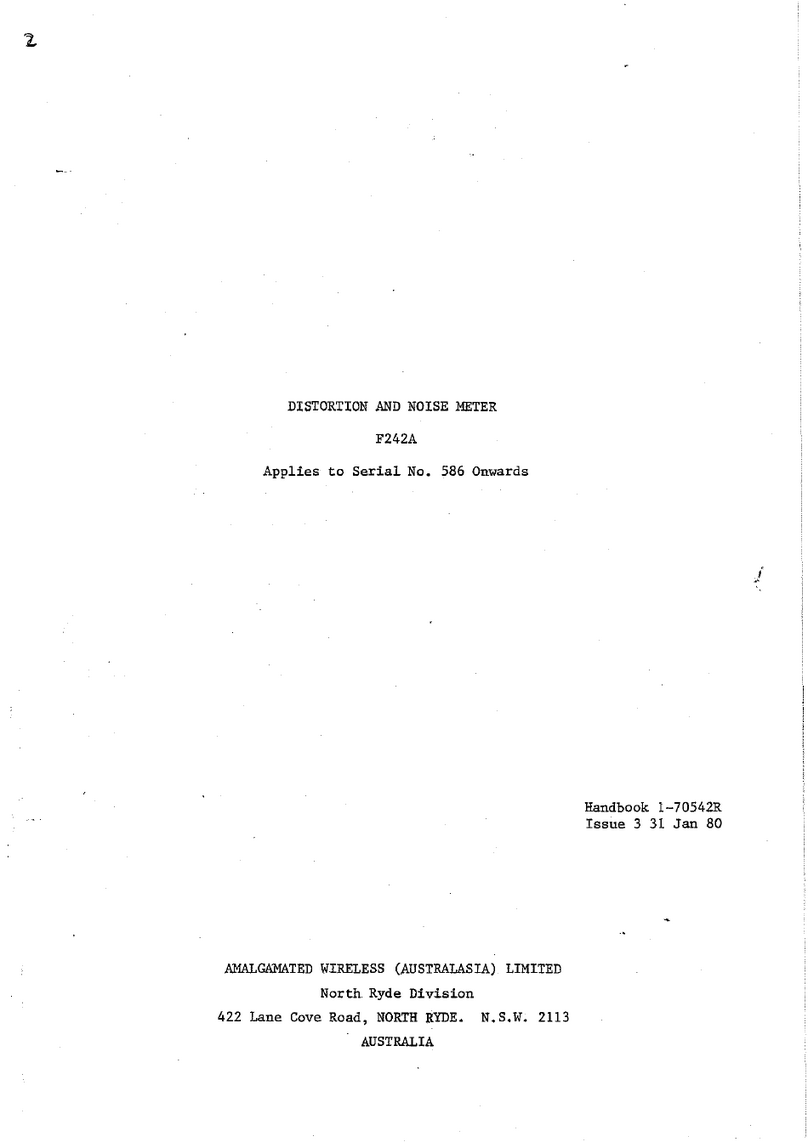Tomey ViewLight FT-1000 User manual

INSTRUCTION MANUAL
NON-CONTACT TONOMETER
FT-1000
Carefully read this instruction manual before
using this instrument to ensure correct and safe
operation.
If you have questions about operations, please
contact Tomey Corporation or our local distributor.
Always follow the operation procedures
described in this manual.
Keep this manual in a readily available
location while operating the instrument.
Contact our local distributor if you lose
this instruction manual.
401A9090-3&


i-1
i Important Safety Information
ڦ
Do not install this instrument in a location where explosives or
inflammable substances are used or stored. Otherwise, fire or
explosion may occur.
ڦ
Do not remove the cover of the instrument.
You may be directly
exposed to high voltage sections.
ڦ
Do not disassemble or modify the instrument.
You may be directly
exposed to high voltage sections.
ڦ
Disconnect the power cord from the instrument before servicing
the instrument. Otherwise, you may get an electric shock.
ڦ
Do not commence service or main
tenance work while the instrument is
being used for a patient.
ڦ
Do not place water or chemicals on the instrument.
Any water or
chemicals entering the instrument may cause an electric shock or
failure.
ڦ
Only use the specified terminal for connection of the instrument.
Using another type of terminal may result in failure of the
instrument.
ڦ
This instrument is a
measuring device specially designed for
ophthalmology.
Never use the instrument for other purposes.
ڦ
The external output terminal is not isolated from the internal circuit.
Inappropriate wiring may damage the internal circuit.
Contact us
before using the external output terminal.

i-2
Never damage or cause caution marks provided for the instrument to become
illegible. Caution labels are provided on the sides, bottom, and physician's side of
the instrument.
If a label is damaged or becomes illegible, please contact Tomey Corporation or
our local distributor.
Caution label

ii-1
ii How to Read This Manual
Outline
This manual is structured as follows.
1. PRIOR TO USE
Describes safety precautions and important information
to be understood before installing and using the
instrument.
2. NAMES AND FUNCTIONS OF PARTS AND
COMPONENTS
Describes names and functions of each section of the
instrument.
3. OPERATION PROCEDURES
Describes information required for installing and using
the instrument.
4. TECHNICAL INFORMATION
Describes useful technical information about the
instrument.
5. INSPECTION AND MAINTENANCE
Describes procedures for replacing consumable parts,
etc. that the user of the instrument should normally
conduct.
6. TROUBLESHOOTING
Describes how to solve problems.
7. CONSUMABLES AND OPTIONAL EQUIPMENT
Describes consumable parts and optional equipment.
8. SPECIFICATIONS
Describes the specifications of the instrument.
9. INDEX
Refer to the index when needed.

ii-2
SYMBOLS USED IN THIS MANUAL
The symbols below indicate the following:
This is a precaution that, if unheeded, will result in
a hazardous situation where there is an imminent
danger of serious injury or death.
This is a precaution that, if unheeded, could result in
a hazardous situation where there is a possibility of
serious injury or death.
This is a precaution that, if unheeded, may result in
a situation where there is a possibility of minor or
moderate injury or damage to property.
This is an additional instruction which may contain a
special precaution on company policy related, either
directly or indirectly, to the safety of personnel or to
the protection of property.

iii-1
I Important Safety Information ........................................................................................ i-1
ii How to Read This Manual ............................................................................................ ii-1
Configuration ........................................................................................................... ii-1
SYMBOLS USED IN THIS MANUAL ...................................................................... ii-2
iii Contents ...................................................................................................................... iii-1
1. PRIOR TO USE .......................................................................................................... 1-1
1.1 Precautions for operation .................................................................................. 1-1
1.2 Checking of shipments ...................................................................................... 1-5
1.3 Glossary ............................................................................................................ 1-6
1.4 Outline of operation ........................................................................................... 1-7
2. NAMES AND FUNCTIONS OF PARTS AND COMPONENTS .................................. 2-1
2.1 Physician's side ................................................................................................. 2-1
2.2 Patient's side ..................................................................................................... 2-3
2.3 Measurement screen ........................................................................................ 2-4
2.4 Operation of the joystick ................................................................................... 2-7
2.5 Touch Alignment ................................................................................................ 2-8
2.6 RS-232C connector .......................................................................................... 2-9
2.7 Symbols used for marking ................................................................................. 2-11
3. OPERATION PROCEDURES .................................................................................... 3-1
3.1 Safety precautions ............................................................................................ 3-1
3.1.1 Precautions for installing the instrument ................................................... 3-1
3.1.2 Precautions for connecting the power cord .............................................. 3-2
3.2 Preparation for measurement ........................................................................... 3-3
3.2.1 Starting ..................................................................................................... 3-3
3.2.2 Setting ...................................................................................................... 3-3
3.2.3 Checking the printer paper ....................................................................... 3-3
3.3 Measurement .................................................................................................... 3-4
3.3.1 Precautions ............................................................................................... 3-5
3.3.2 Patient's eye height adjustment ................................................................ 3-5
3.3.3 Nozzle limiter setting ................................................................................ 3-6
3.3.4 Alignment .................................................................................................. 3-8
3.3.5 Measuring intraocular pressure ................................................................ 3-10
3.3.6 Popup window for selecting the measurement range ............................... 3-13
3.3.7 Popup window for loading low reliable data ............................................. 3-13
3.4 Printout .............................................................................................................. 3-14
3.4.1 Printing procedures .................................................................................. 3-14
3.4.2 Printing format .......................................................................................... 3-15
3.5 Display of the data in the memory .................................................................... 3-17
3.5.1 Viewing the measurement data ................................................................ 3-17
3.5.2 Adjusting the measurement data .............................................................. 3-18
3.6 Data communication ......................................................................................... 3-19
3.6.1 Entering the ID and patient's name .......................................................... 3-19
iii Contents

iii-2
3.6.2 Receiving the patient data ........................................................................ 3-21
3.6.3 Sending the examination data .................................................................. 3-22
3.7 Settings ............................................................................................................. 3-24
3.7.1 Initial setup (Setup) ................................................................................... 3-24
3.7.2 Temporary setup (Temporary) .................................................................. 3-30
4. TECHNICAL INFORMATION ..................................................................................... 4-1
4.1 Adjusting intraocular pressure according to cornea thickness .......................... 4-1
4.2 Performance test result for the device .............................................................. 4-2
4.2.1 Method....................................................................................................... 4-2
4.2.2 Result ........................................................................................................ 4-2
4.3 NON-CONTACT TONOMETER FT-1000 Clinical data (ISO8612:2001) .......... 4-3
5. INSPECTION AND MAINTENANCE .......................................................................... 5-1
5.1 Warranty ............................................................................................................ 5-1
5.2 Durable years .................................................................................................... 5-2
5.3 Inspection .......................................................................................................... 5-2
5.4 Routine maintenance ........................................................................................ 5-3
5.4.1 Measurement window ............................................................................... 5-3
5.4.2 Forehead pad ........................................................................................... 5-4
5.4.3 Outer surface ............................................................................................ 5-4
5.5 Replacing consumables .................................................................................... 5-5
5.5.1 Printer paper ............................................................................................. 5-5
5.5.2 Fuses ........................................................................................................ 5-6
5.5.3 Chin rest paper ......................................................................................... 5-6
5.6 Storing ............................................................................................................... 5-7
5.7 Disposal ............................................................................................................ 5-8
6. TROUBLESHOOTING ............................................................................................... 6-1
7. CONSUMABLES AND OPTIONAL DEVICES ............................................................ 7-1
8. SPECIFICATIONS ...................................................................................................... 8-1
8.1 Specifications .................................................................................................... 8-1
8.1.1 Measuring IOP .......................................................................................... 8-1
8.1.2 Main unit ................................................................................................... 8-1
8.1.3 Power source ............................................................................................ 8-1
8.2 Energy and other consumption ......................................................................... 8-2
8.3 Noise ................................................................................................................. 8-3
8.4 Operating environment ..................................................................................... 8-3
8.5 Classification ..................................................................................................... 8-4
8.6 Declaration of conformity with EMC .................................................................. 8-5
9. INDEX ......................................................................................................................... 9-1

1-1
1. PRIOR TO USE
Read this manual thoroughly before using the
instrument to ensure proper and safe operation.
Always follow the operation procedures described in
this manual.
Check that there is no device that generates
strong magnetic field near the instrument. The
strong magnetic field may cause noise and affect
measurement.
1.1 Precautions for operation
Only allow adequately skilled operators to use the instrument.
Precautions for installing the instrument
– Install the instrument in a location free of water or chemicals. Any water or
chemicals entering the instrument may cause an electric shock or failure.
– Do not install the instrument in a place where chemicals are stored or gases
may occur. Spilt chemicals or vapor may enter the instrument and ignite.
– Check the frequency, voltage, and allowable current (or power consumption)
of the power source. Operating the instrument connected to an inappropriate
power source may cause fire or an electric shock.
– Connect the power plug to a grounded 3P-outlet. Otherwise, a short circuit due
to failure of the instrument may result in an electric shock.
– Do not place any heavy object on the power cord or squash the power cord.
This may cause fire or an electric shock.
– Completely insert the power plug into the outlet. Faulty contact, allowing any
metal to contact exposed plug terminals, or dust accumulated on exposed plug
terminals may result in fire or an electric shock.
– Do not connect any device with data transmission specifications that are not
compatible with the instrument. Connecting such a device may cause fire or an

1-2
electric shock. When connecting a device to the instrument using the RS-232C
connector, contact Tomey Corporation or our local distributor.
– Ground the instrument appropriately. Otherwise you may get an electric shock.
– Do not hold the measuring head, chin rest, forehead pad, or joystick when
lifting the instrument. These components are detachable and the instrument
may drop, resulting in injuries.
– Install the instrument in a location not subject to direct sunlight, high
temperature and humidity, or air with significant dust, salt, and/or sulfur
content. These may cause failure or malfunction of the instrument.
– Install the instrument in a level and stable location free of vibration or
mechanical impact to ensure correct measurement, and prevent the instrument
from falling or being dropped, resulting in fire or fatal accidents.
– Install the instrument between the patient and physician so that they can face
with each other.
– Install the instrument in a location that it is sufficiently clear of any other
equipment that may interfere with the examination when using the instrument.
Precautions before using the instrument
– Check that all cables are connected correctly and completely.
– Check the sections that the patient will directly touch.
– Peel off the top sheet of chin rest paper and clean the forehead pad with a
cloth dampened with alcohol before measurement.
– Check that the instrument is correctly grounded.
– Check that the date set in the instrument conforms to the actual operation date
and time.
Precautions during operation
– Do not place any container with liquid in it on the instrument. Any liquid
entering the instrument may cause an electric shock or failure.
– If any smoke, offensive odor, or abnormal sound occurs, turn off the
instrument immediately, disconnect the power plug from the outlet, and contact
our local distributor or Tomey Corporation.

1-3
– When moving the measuring head and/or chin rest of the instrument, pay
attention to the position of the patient's face, hands, and fingers. The patient
may be injured by the moving section of the instrument.
– When supporting the patient’s face with a hand, pay the utmost attention to the
position of the hand or fingers and carefully operate the instrument. The hand
or fingers may be caught between the head and forehead pad, resulting in
injuries.
– Do not allow any person to place their hands or fingers in the clearance under
the measuring head or the section under the chin rest. Their hands or fingers
may be crushed and injured.
– Do not lean on the instrument or press on the instrument from the top. The
instrument may fall, resulting in mechanical failure or injuries.
– Complete the measurement within the prescribed time and repetitions.
– Observe both the instrument and patient to ensure there are no problems.
– If a problem with the instrument or the patient occurs, take appropriate action
such as stopping the machine to ensure the safety of the patient.
– Do not allow the patient to touch the instrument.
– Never touch the cutter in the printer, or you may be injured.
– Peel off the top sheet of chin paper and clean the forehead pad with a clean
cloth before measuring the next patient. Clean the forehead pad and chin rest
with a cloth dampened with alcohol as needed.
Precautions after operation
– Do not place any container with liquid in it on the instrument. any liquid
entering the instrument may cause an electric shock or failure.
– Do not use organic solvents such as thinner, benzene, or acetone to clean the
instrument. These solvents may cause fire or an electric shock, and may also
corrode the resin or coating of the cover of the instrument.
– Hold the plug when disconnecting the power cord from the outlet to avoid
applying excessive force on the cord. Pulling the cord may damage inner core
wires, resulting in electric shock or fire.
– Disconnect the power cord when the instrument is not operated for a long
period of time.

1-4
– Refer to "5.6 Storing" for instructions on storing the instrument.
– Clean the instrument appropriately at the end of operation to get ready for the
next operation.
– Clean and neatly arrange the accessories and cables.
– If any smoke, offensive odor, or abnormal sound occurs, turn off the instrument
immediately, disconnect the power plug from the outlet, and contact our local
distributor or Tomey Corporation.
If any instrument failure occurs, stop operation immediately, indicate the failure,
and contact our local distributor to request repair.
– Never modify the instrument. Doing so may cause electric shock or failure of
the instrument. The instrument contains high-voltage sections. Touching these
sections will result in death or serious injuries.
– Disconnect the power cord from the outlet when replacing fuses. Otherwise
you may get an electric shock, resulting in death or serious injuries.
– Use the power cord and fuses provided with the instrument or specified by
Tomey to ensure safety. Also, do not use the accessories provided with the
instrument for other equipment.
– When any instrument failure occurs, indicate the failure, and contact our
local distributor to request inspection and repair. Do not attempt to repair the
instrument yourself.
– Conduct regular inspections of the instrument and components.
– When the instrument is not used for 1 month or longer, refer to "5.3 Inspection"
in this manual and check that the instrument is operating correctly and safely
before starting operation.

1-5
1.2 Checking contents of package
Open the package and check that the specified amount of the following items are
included in the package and are not damaged. If any item is missing or damaged,
contact our local distributor as soon as possible.
Keep the box and packing materials for use when
moving or transporting the instrument.
When taking the instrument out of the box, pull the
outer box upward and then remove the packing
materials. Be careful not to lift the instrument up
by directly holding the measuring head, chin rest,
forehead pad, or joystick. The instrument may be
damaged.
Main unit of
NON-CONTACT TONOMETER FT-1000
.... 1
Power cord ...................................................... 1
Fuses (2 fuses are installed in the main unit) .. 4
Chin rest paper ................................................ 1
Pins for Chin rest paper ................................... 2
Printer paper (One is already installed.) .......... 3
Dust cover ....................................................... 1
INSTRUCTION MANUAL (this book) .............. 1
DATA Transfer Installation CD ......................... 1
DATA Transfer startup guide ............................ 1

1-6
1.3 Glossary
[aIOP]: Intraocular pressure adjusted according to the cornea thickness
(CCT)
[mIOP]: Measured intraocular pressure
[AVG]: Average of measured intraocular pressure
[CCT]: Central cornea thickness
[IOP]: Intraocular pressure
[Temporary]: Function to temporarily change the measuring condition(s)
[TOMEY Link]: Digital medical record system to control the data measured with
Tomey products
[DATA Transfer]: System to output the measurement data from Tomey products
to digital files
[Auto Measurement mode]: Mode to automatically conduct alignment and measurement
[Auto Shot]: Function to automatically conduct measurement when the sight
in up/down/right/left/focus directions becomes optimal
[Auto Alignment]: Function to automatically align the sight in up/down/right/left/
focus directions
[Auto Power Off]: Function to automatically turn the LCD off, with only the power
lamp flashing, when the instrument is not operated for the
specified time (Auto Power Off mode). Touch any button to
return to Normal mode.
[Quick mode]: The measuring head retracts from the patient's eye after
measurement is completed in Normal mode; however, in Quick
mode, the next measurement can be conducted continuously
without retracting the measuring head. This is effective when
the sight of the patient is unstable and difficult to be aligned.
[Touch Alignment]: Function to move the measuring head by touching the screen;
used for rough alignment
[Touch panel]: Allows you to make various settings and execute the touch
alignment function by directly touching the screen.
[Manual Measurement mode]: Mode to manually conduct alignment and measurement by
operating the joystick.

1-7
1.4 Outline of operation
This instrument is designed to calculate the
intraocular pressure. For more details regarding
accuracy, precision, and clinical comparison of the
IOP measurements to the Goldmann applanation
tonometer please refer to Section 4.3 of the
Instruction Manual.
FT-1000 is an instrument used to measure the intraocular pressure of a patient's eye.
The patient this instrument is indicated for the measurement of intraocular pressure
without contacting the eye to aid in the screening and diagnosis of glaucoma places
their chin on the chin rest and looks into the sight-fixing lamp in the measurement
window to fix their sight.
After the physician observes the patient's eye on the monitor screen and roughly aligns
the measuring position, fine alignment and measurement is automatically conducted.
When the intraocular pressure cannot be measured automatically, align the measuring
position with the joystick and press the measurement button to start measurement.
When measurement has started, air blows from the nozzle of the measurement
window. When the cornea becomes flat due to blown air, corneal reflex light from the
light source is received by the light receiving element. The instrument calculates the
intraocular pressure according to the air pressure at this moment and shows the result
on the monitor screen.
Touch the "PRINT" button to print out the measurement data.

1-8
This page is intentionally left blank.

2-1
2. NAMES AND FUNCTIONS OF PARTS
AND COMPONENTS
2.1 Physician's side
(1) Measuring head
Section that conducts measurement.
(2) Monitor / touch panel
Displays the measurement screen and various setting screens. Touch the touch panel
buttons shown on the LCD to make various settings and operate the instrument.
(3) Joystick
Tilting the joystick to the right, left, back, and forth moves the measuring head to the right,
left, forward, and backward for fine positioning.
(4) Measuring switch
Starts measurement.
(5) Up/down ring
Moves the measuring head up and down. Moving the ring up and down moves the
measuring head for rough positioning. Turning the ring moves the head for fine positioning.
(1)
(2)
(3)
(4) (5)
(6)
(7)
(8)
(9)
(10)
(1
1)
(12)
(13)
(17)
(14)
(15)
(16)
(18)
(19)

2-2
(6) Hand rest
Place your hand on the rest to operate the joystick. Sliding the rest forward, backward, to the
right, and left moves the measuring head in the corresponding direction for rough positioning.
(7) Printer
Prints the measurement data.
(8) Eye level mark
Reference mark when aligning the height of the patient's eye
(9) RS-232C connector
Connection terminal to connect external equipment
(10) Service mode switch
This switch is reserved for use by serviceman performing maintenance work. Do not operate
this switch.
(11) "CLEAR" button
Deletes the examination data.
(12) 1 <=> 3 button (select number of measurements)
Sets the number of times measurement is performed ("1" or "3") when Auto Shot is ON.
(13) "PRINT" button
Manually prints the measurement results.
(14) "AUTO" button
Manually switches the operation mode (AUTO or MANUAL).
(15) "LIMITER" button
Determines the stop position of the measuring head to prevent the nozzle from contacting
the patient's eye.
(16) "TOMEY Link" button
Sends the measurement data to TOMEY Link or DATA Transfer.
(17) "PACKING" button
Pressing this button for 3 seconds moves the measuring head to the lowest position for
packing (lower dead center).
(18) "CHIN REST" button
Touching the UP and DOWN buttons moves the chin rest up and down respectively.
(19) Power lamp
Stays lit while the instrument is turned on.

2-3
2.2 Patient's side
(1) Measurement window
Blows air onto the patient's eye from the center nozzle.
(2) Chin rest
The patient places their chin on this rest.
(3) Forehead pad
The patient presses their forehead against this pad.
(4) Power switch
Press the [I] or [O] side to turn the instrument on or off respectively.
(5) Power connector
Connect the power cord here.
(6) Fuse holder
Insert the fuses here.
(1)
(2)
(3)
(4)
(5)
(6)

2-4
2.3 Measurement screen
(1) Eye display button [R]/[L]
Displays the right or left eye on which the measuring head is positioned, using the
corresponding color. Touch this icon to move the measuring head when changing the eye to
be examined.
(2) Examination number [No.]
Indicates the examination number. The number increases in increments of 1 whenever a
new measurement is started.
(3) ID number [ID]
Displays an ID number when external communication is activated.
(4) Safety function cancellation
This mark appears when any safety function is disabled in the setting. Check the details of
the setting and operate the instrument with the utmost cares.
(5) 3 data output
This marks appears when “3” is selected for the data output setting. Only the most reliable
three data will be displayed on the screen, printed out, and output.
(21)
(22)
(27) (28)
(28)
(26)
(23) (24)
(25)
(1)
(2) (4) (5) (6) (7)
(9)(10) (11) (12) (13) (14)
(19)
(18)
(16)
(15)
(17)
(17)
(18)
(19)
(20)
(20)
(3) (8)
Table of contents
Other Tomey Measuring Instrument manuals
